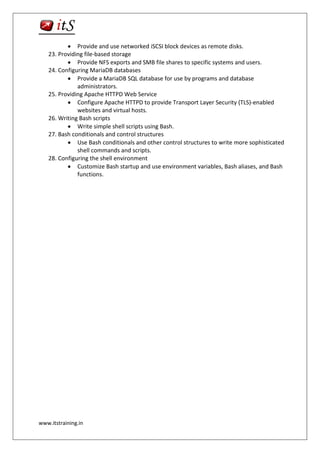Rh299
- 1. www.itstraining.in RH299: Red Hat Certified Engineer(RHCE) Duration: 04 Days Prerequisite Courses Students should have already completed Red Hat System Administration I, II, and III or equivalent training. Or have attended RH199 training. Intended Audience • RHCSAs who wish to earn a more senior-level credential. • Experienced senior system administrators who have not yet certified. • Course participants in Red Hat Training who have completed System Administration I, II, and III, or who have completed the RHCE Rapid Track Course. • Experienced system administrators who require certification for their job or by mandate Overview This course is intended for candidates who are looking for a hands-on, lab-based review prior to taking the RHCE exam. After completing this course, senior Linux administrator students will have understood all the intermediary and advanced competencies tested by the RHCE and RHCSA exams. • Configuring static routes, packet filtering, and network address translation • Setting kernel runtime parameters • Configuring an Internet Small Computer System Interface (iSCSI) initiator • Producing and delivering reports on system utilization • Using shell scripting to automate system maintenance tasks • Configuring system logging, including remote logging • Configuring a system to provide networking services, including HTTP/HTTPS, File Transfer Protocol (FTP), network file system (NFS), server message block (SMB), Simple Mail Transfer Protocol (SMTP), secure shell (SSH) and Network Time Protocol (NTP) Course Outline 1. Local and remote logins • Review methods for accessing the system and engaging Red Hat Support. 2. File system navigation • Copy, move, create, delete, link, and organize files while working from the Bash shell prompt. 3. Users and groups • Manage Linux users and groups and administer local password policies. 4. File permissions • Control access to files and directories using permissions and access control lists (ACLs).
- 2. www.itstraining.in 5. SELinux permissions • Manage the SELinux behavior of a system to keep it secure in case of a network service compromise. 6. Process management • Evaluate and control processes running on a Red Hat Enterprise Linux system. 7. Updating software packages • Download, install, update, and manage software packages from Red Hat and yum package repositories. 8. Creating and mounting file systems • Create and manage disks, partitions, and filesystems from the command line. 9. Service management and boot troubleshooting • Control and monitor system daemons and troubleshoot the Red Hat Enterprise Linux boot process. 10. Network configuration • Configure basic IPv4 networking on Red Hat Enterprise Linux systems. 11. System logging and ntp • Locate and accurately interpret relevant system log files for troubleshooting purposes. 12. Logical volume management • Create and manage logical volumes from the command line. 13. Scheduled processes • Schedule tasks to automatically execute in the future. 14. Mounting network file systems • Use autofs and the command line to mount and unmount network storage with NFS and SMB. 15. Firewall configuration • Configure a basic firewall. 16. Virtualization and kickstart • Automate the installation of Red Hat Enterprise Linux on virtual machines with kernel-based virtual machine (KVM) and libvirt. 17. Managing IPv6 networking • Configure and troubleshoot basic IPv6 networking on Red Hat Enterprise Linux systems. 18. Configuring link aggregation and bridging • Configure and troubleshoot advanced network interface functionality including bonding, teaming, and local software bridges. 19. Controlling network port security • Permit and reject access to network services using advanced SELinux and firewalld filtering techniques. 20. Managing DNS for Servers • Set and verify correct DNS records for systems and configure secure-caching DNS. 21. Configuring E-mail Delivery • Relay all e-mail sent by the system to a SMTP gateway for central delivery. 22. Providing block-based storage
- 3. www.itstraining.in • Provide and use networked iSCSI block devices as remote disks. 23. Providing file-based storage • Provide NFS exports and SMB file shares to specific systems and users. 24. Configuring MariaDB databases • Provide a MariaDB SQL database for use by programs and database administrators. 25. Providing Apache HTTPD Web Service • Configure Apache HTTPD to provide Transport Layer Security (TLS)-enabled websites and virtual hosts. 26. Writing Bash scripts • Write simple shell scripts using Bash. 27. Bash conditionals and control structures • Use Bash conditionals and other control structures to write more sophisticated shell commands and scripts. 28. Configuring the shell environment • Customize Bash startup and use environment variables, Bash aliases, and Bash functions.



